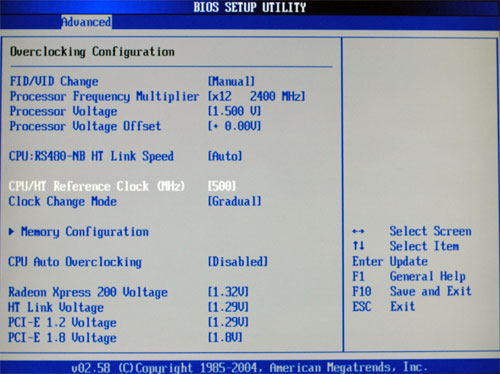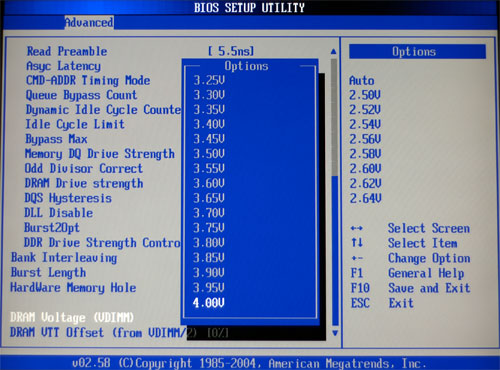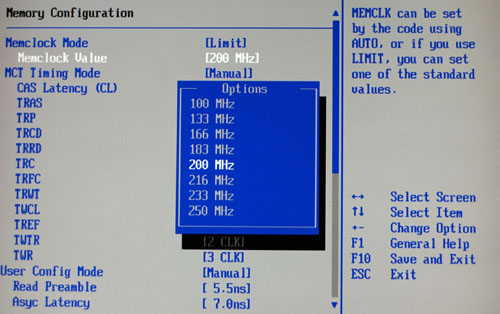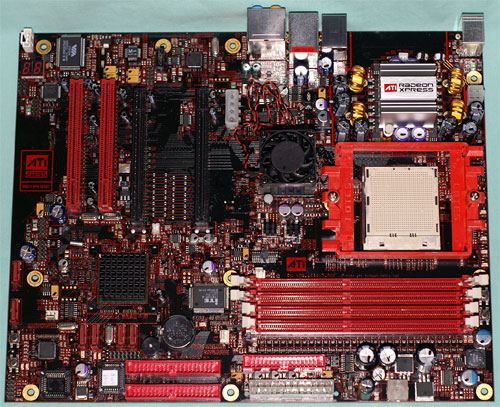ATI’s Crossfire: Best Overclocker on the Market?
by Wesley Fink on September 27, 2005 12:05 AM EST- Posted in
- CPUs
Basic Features: ATI Crossfire AMD Reference Board
It is almost heresy to call the options and adjustments on the Crossfire AMD "Basic Features", since they are clearly the best that we have ever seen on any AMD motherboard. The DFI nForce4 Ultra and SLI boards have quickly developed a reputation for offering the enthusiast every imaginable BIOS option. We mention the DFI only to put in perspective that the ATI offers 2 more memory adjustments not found on the DFI, a wider range of vDIMM to 4.0V, and even more controls to tweak the performance of the motherboard. It is clear that ATI has worked with a lot of enthusiasts in refining the Crossfire AMD - it shows in the depth and breadth of available options.
At the other end of the spectrum, ATI also offers automatic overclocking options in the BIOS for those uncomfortable with manual overclocking. You can dial in 1% to 15% overclocking and the board handles all the adjustments for you.
The ATI also has memory adjustments to DDR500 with the 4000+ Clawhammer processor that we use for standard benchmarking. The ability to run the processor at stock speed with memory at up to DDR500 opens new options for memory performance. You can do things like run the CPU at stock speed and the memory at DDR500.
Reference Boards are designed for qualification and we are certain that many would find the lack of any x1/x2 PCIe slots and just 2 PCI slots to be a concern if this were a production board. We saw a different slot arrangement on the Gigabyte ATI Crossfire AMD, and you will likely see many different slot configurations on production boards.
You may have noticed that the Gigabyte that we previewed several months ago controlled Crossfire with a "paddle board" similar to what we are accustomed to on NVIDIA. The AMD Reference Board does not use a paddle-card and all switching is done in the BIOS. In fact, the AMD Reference Board is capable of full auto-switching of single or dual video cards with no adjustments required in the BIOS if left in "Auto" mode. A number of video switching options are available to motherboard manufacturers.
| ATI Crossfire AMD Reference Board | |
| CPU Interface | Socket 939 Athlon 64 |
| Chipset | ATI RD480 Northbridge - ATI SB450 Southbridge |
| Bus Speeds | 200 to 500MHz in 1MHz Increments |
| Memory Speeds | DDR200,266,333,366,400,433,466,500 |
| PCIe Speeds | 100 to 200MHz in 1MHz increments |
| PCI/AGP | Fixed at 33/66 |
| Core Voltage | Auto, 0.825V to 1.55V in 0.025V increments PLUS .0V to 0.6V in 0.02V increments (Maximum vCore 2.15V) |
| CPU Clock Multiplier | 4x-25.5x in 0.5X increments |
| DRAM Voltage | Auto, 2.5V to 3.0V in .02V increments 3.0V to 4.0V in .05V increments (Maximun Memory Voltage 4.0V) |
| HyperTransport Frequency | 1000MHz (1GHz) |
| HyperTransport Multiplier | Auto, 1X to 5X |
| HyperTransport Voltage | 1.22V, 1.29V, 1.39V, 1.5V |
| Xpress 200 Voltage | 1.22V, 1.29V, 1.39V, 1.5V |
| PCIe 1.2 Voltage | 1.22V, 1.29 V, 1.39 V, 1.5V |
| PCIe 1.8 Voltage | 1.8V, 1.9V |
| Auto Overclocking | 1% to 15% |
| Memory Slots | Four 184-pin DDR DIMM Slots Dual-Channel Configuration Regular Unbuffered Memory to 4GB Total |
| Expansion Slots | 2 PCIe x16 2 PCI Slots |
| Onboard SATA/RAID | 4 SATA Drives by SB450 (RAID 0, 1, JBOD) 2 SATA II Drives by Sil 3231 |
| Onboard IDE/IDE RAID | Two Standard ATA133/100/66 (4 drives) |
| Onboard USB 2.0/IEEE-1394 | 8 USB 2.0 ports supported by SB450 2 1394 Firewire by VIA |
| Onboard LAN | Gigabit PCIe Ethernet by Marvel 88E8052 |
| Onboard Audio | Azalia HD Audio by Realtek ALC880 |
| BIOS | AMI Build 50 and Award Build 54 |
It is almost heresy to call the options and adjustments on the Crossfire AMD "Basic Features", since they are clearly the best that we have ever seen on any AMD motherboard. The DFI nForce4 Ultra and SLI boards have quickly developed a reputation for offering the enthusiast every imaginable BIOS option. We mention the DFI only to put in perspective that the ATI offers 2 more memory adjustments not found on the DFI, a wider range of vDIMM to 4.0V, and even more controls to tweak the performance of the motherboard. It is clear that ATI has worked with a lot of enthusiasts in refining the Crossfire AMD - it shows in the depth and breadth of available options.
At the other end of the spectrum, ATI also offers automatic overclocking options in the BIOS for those uncomfortable with manual overclocking. You can dial in 1% to 15% overclocking and the board handles all the adjustments for you.


The ATI also has memory adjustments to DDR500 with the 4000+ Clawhammer processor that we use for standard benchmarking. The ability to run the processor at stock speed with memory at up to DDR500 opens new options for memory performance. You can do things like run the CPU at stock speed and the memory at DDR500.
Reference Boards are designed for qualification and we are certain that many would find the lack of any x1/x2 PCIe slots and just 2 PCI slots to be a concern if this were a production board. We saw a different slot arrangement on the Gigabyte ATI Crossfire AMD, and you will likely see many different slot configurations on production boards.
You may have noticed that the Gigabyte that we previewed several months ago controlled Crossfire with a "paddle board" similar to what we are accustomed to on NVIDIA. The AMD Reference Board does not use a paddle-card and all switching is done in the BIOS. In fact, the AMD Reference Board is capable of full auto-switching of single or dual video cards with no adjustments required in the BIOS if left in "Auto" mode. A number of video switching options are available to motherboard manufacturers.












40 Comments
View All Comments
n00b1e - Tuesday, September 27, 2005 - link
Great article, but how about benchmarking real apps on the overclocked settings and comparing the result to the non-overclocked ones instead of just comparing the highest attainable memory/bus speed overclocks?Quanticles - Tuesday, September 27, 2005 - link
Another bought review..."The ATI Crossfire AMD has every option a serious overclocker could wish for."
How about the option to use a CRT? I like to use 1600x1200 at 85 Hz.
Wesley Fink - Tuesday, September 27, 2005 - link
A 7800GTX or X1800 can easily do 1600x1200 at 85 Hz - and probably outperform X850XT Crossfire. It's all a matter of perspective.In addition, Derek has already said the next gen (X1800), due out in less than 2 weeks, does not have this limitation in Crossfire mode. That's why he did not recommend Crossfire X850/X800 and said to wait a short while. THAT Crossfire solution will also work on this board.
ChronoReverse - Tuesday, September 27, 2005 - link
Red Herring. We're talking about the motherboard and how wellit can overclock the cpu). The graphics card is irrelevant (and the limitation on the xfire cards themselves not the motherboard).Myrandex - Tuesday, September 27, 2005 - link
2nd page:The various ATI Radeon Xpress 200 north bridges can also be combined with ULi south bridges. The current ULi 1573 provides all the features of the ATI BS450 except integrated Gigabit Ethernet.
should be SB450
Wesley Fink - Tuesday, September 27, 2005 - link
I have spoken witrh ATI and several mfgs this morning to update board availability. Between today and the 2nd week of October we should see RETAIL Crossfire motherboards appear from DFI, Gigabyte, ECS, MSI, Asus and a few others. RETAIL availability means you will be able to buy them at New Egg or other e'tailers at that time.X850XT Master Cards are expected to be for sale RETAIL tomorrow, September 28th, with X800 Master Cards several weeks away.
I have a Gigabyte Crossfire AMD in my hands as I write this. It is the release Vewrsion 1.0 board and I received the release BIOS this morning.
eastvillager - Tuesday, September 27, 2005 - link
"yeah, we know our usb performance sucks on SB400, we're fixing it in SB450""Yeah, we know our usb performance sucks on SB450, we're fixing it in SB600"
prediction:
"Yeah, we still don't have USB 2.0 working properly on SB600, wait till SB700, when USB 3.0 comes out and we'll be ok."
Kind of hard to understand how they can do just about everything else on the mobo correctly, but continually screw up USB 2.0. USB 2.0 is a commodity at this point, it is just suppose to work, with no worries, etc.
I use USB 2.0 on a daily basis, it really isn't an area I'm willing to slack on.
Leper Messiah - Tuesday, September 27, 2005 - link
Hm. I'm getting a new mobo soon (as in the next 2 weeks). Is this a paper launch, or will we see single slot solutions out there soon? nVidia has set a precedent with the instant availiblity and massive volume (relatively, I mean they're selling below MSRP for a reason) of their 7800 series. It could be more damaging than delaying the R520 if they don't have it and this mobo out STAT.Would be kinda funny though...for years I've run nVidia chipsets and ATi graphics. Looks like it might get reversed...
allnighter - Tuesday, September 27, 2005 - link
Agreed. Not that I'm referring to AT's conclusions being questionable in any way, shape or manner, I know they say what they see, but it's pretty much obvious that ever manufacturer/vendor simply handpicks any given piece of hardware that is sent to AT for review, since they all know that AT is pretty much the most trusted site. Although I appreciate early previews we get here, I'm a much bigger fan of reviews of retail products. That's about what you'll be able to buy, right away or in just a couple of weeks. Many of these reference pieces are on steroids and simply never materialize in real world performance.Other than that - a very good write up, as usuall.
TehSloth - Tuesday, September 27, 2005 - link
Well mates, this sure does look nifty, but remember what happened to the RS480, which also received Anand's accolades as the best overclocking reference board ever, they couldn't release it right. The Gigabyte board that they talk about in the article was never actually released, and I have a long chain of correspondence with them as it got pushed back more and more. MSI, ECS, and Jetway were the only manufacturers that delivered, and they disabled all the OCing options. Psshhhah!